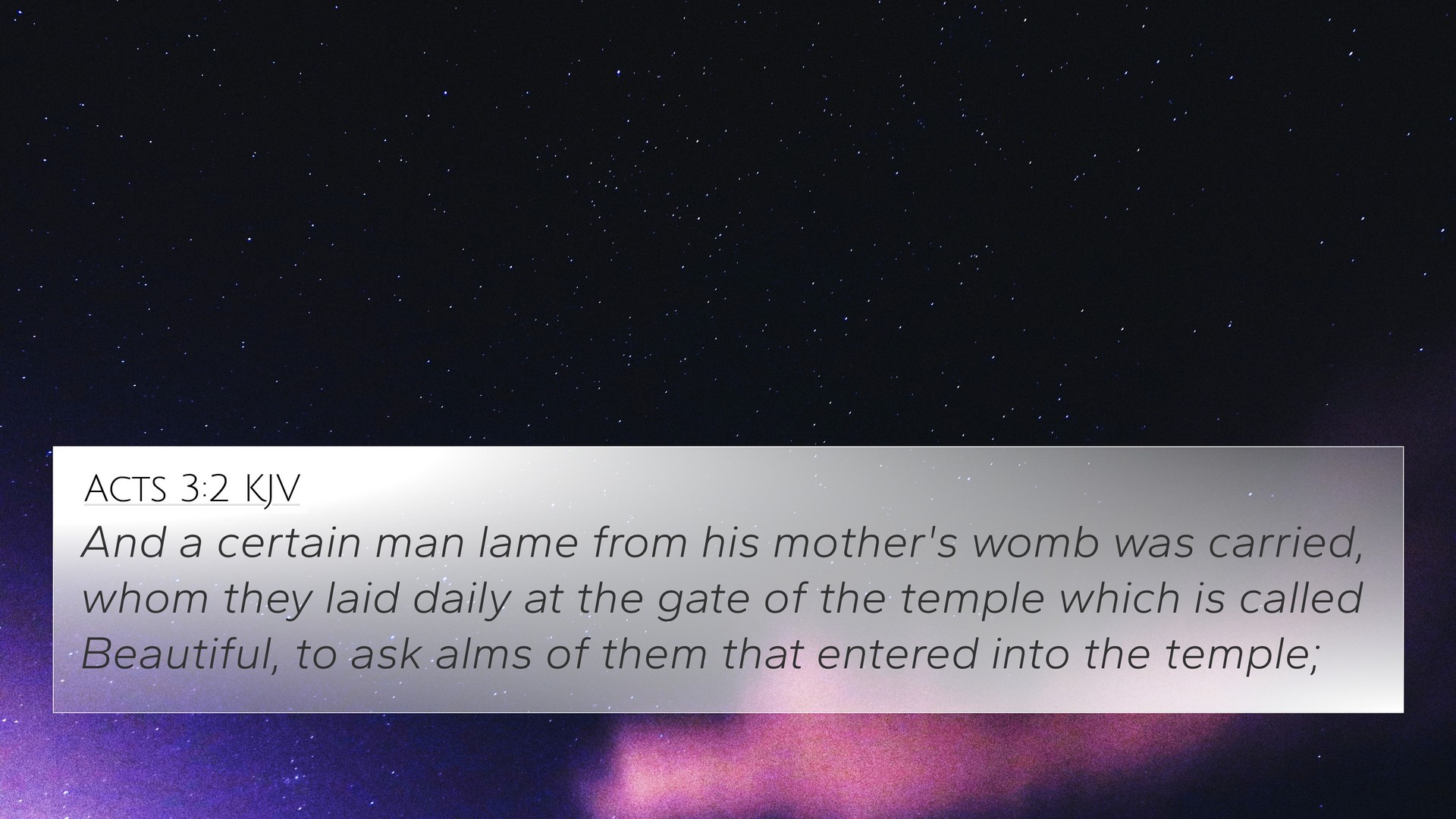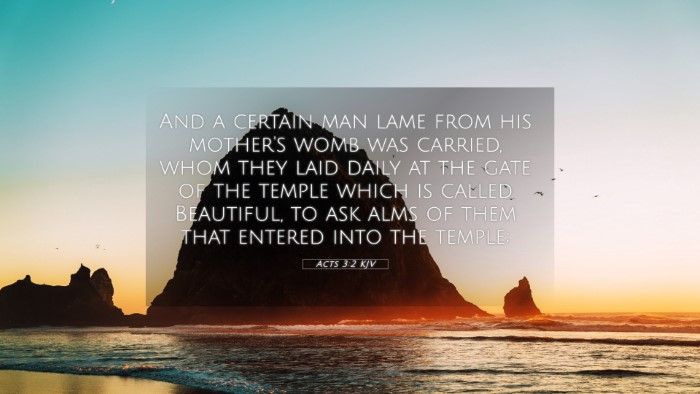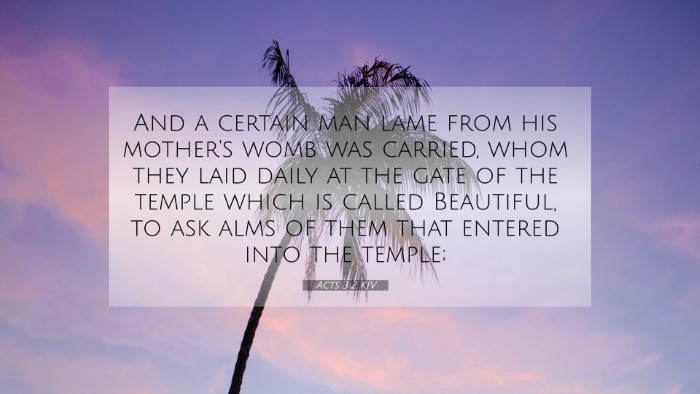Old Testament
Genesis Exodus Leviticus Numbers Deuteronomy Joshua Judges Ruth 1 Samuel 2 Samuel 1 Kings 2 Kings 1 Chronicles 2 Chronicles Ezra Nehemiah Esther Job Psalms Proverbs Ecclesiastes Song of Solomon Isaiah Jeremiah Lamentations Ezekiel Daniel Hosea Joel Amos Obadiah Jonah Micah Nahum Habakkuk Zephaniah Haggai Zechariah MalachiActs 3:2 Similar Verses
Acts 3:2 Cross References
And a certain man lame from his mother's womb was carried, whom they laid daily at the gate of the temple which is called Beautiful, to ask alms of them that entered into the temple;
Uncover the Rich Themes and Topics of This Bible Verse
Listed below are the Bible themes associated with Acts 3:2. We invite you to explore each theme to gain deeper insights into the Scriptures.
Acts 3:2 Cross Reference Verses
This section features a detailed cross-reference designed to enrich your understanding of the Scriptures. Below, you will find carefully selected verses that echo the themes and teachings related to Acts 3:2 KJV. Click on any image to explore detailed analyses of related Bible verses and uncover deeper theological insights.
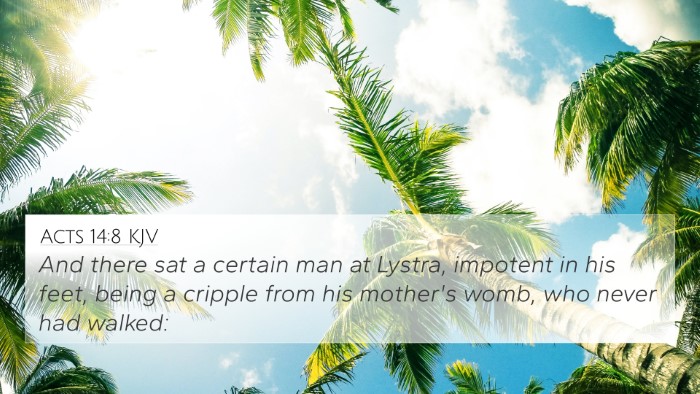
Acts 14:8 (KJV) »
And there sat a certain man at Lystra, impotent in his feet, being a cripple from his mother's womb, who never had walked:

John 9:8 (KJV) »
The neighbours therefore, and they which before had seen him that he was blind, said, Is not this he that sat and begged?

Luke 16:20 (KJV) »
And there was a certain beggar named Lazarus, which was laid at his gate, full of sores,

Luke 18:35 (KJV) »
And it came to pass, that as he was come nigh unto Jericho, a certain blind man sat by the way side begging:
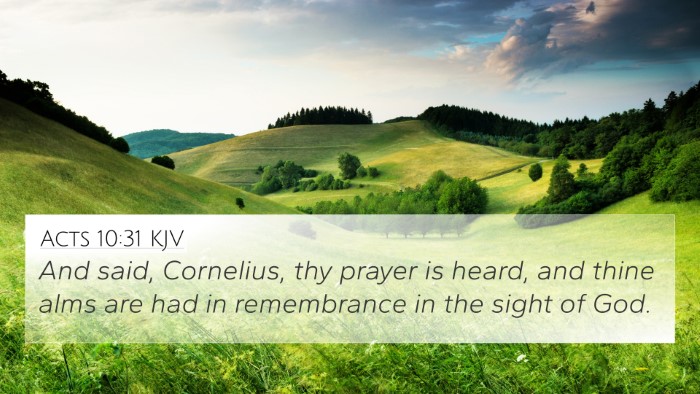
Acts 10:31 (KJV) »
And said, Cornelius, thy prayer is heard, and thine alms are had in remembrance in the sight of God.
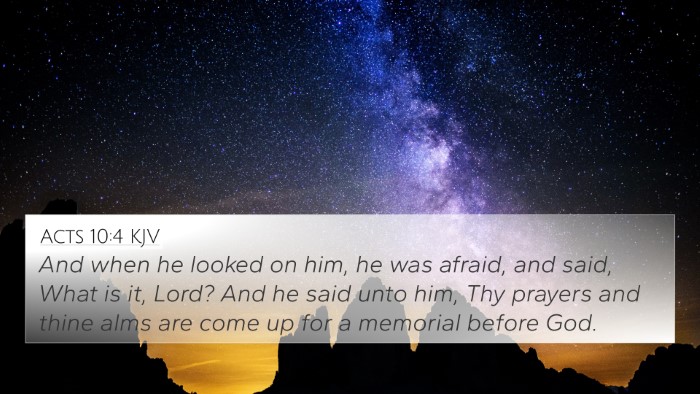
Acts 10:4 (KJV) »
And when he looked on him, he was afraid, and said, What is it, Lord? And he said unto him, Thy prayers and thine alms are come up for a memorial before God.

Acts 4:22 (KJV) »
For the man was above forty years old, on whom this miracle of healing was shewed.
Acts 3:2 Verse Analysis and Similar Verses
Understanding Acts 3:2
Acts 3:2 reads: "And a certain man lame from his mother's womb was carried, whom they laid daily at the gate of the temple which is called Beautiful, to ask alms of them that entered into the temple." This verse sets the stage for a powerful miracle performed by the apostles Peter and John, establishing significant themes of healing, faith, and divine intervention.
Summary of the Verse
This verse introduces a man who had been lame since birth, highlighting the extent of his disability and the societal condition that prevented him from participating fully in community life. His daily placement at the temple gate reflects his dependence on the generosity of others, as he seeks alms—funds or food given to the needy. The 'Beautiful Gate' serves as a symbolic location, suggesting that he was positioned in a place where worshippers were likely to pass, increasing his chances of receiving help.
Commentary Insights
Matthew Henry’s Commentary
Henry emphasizes the man's condition, stressing its lifelong duration. He notes the mercy involved in his situation, as being laid at the temple indicates a faint hope of receiving aid. Henry also points out that this case is emblematic of humanity's need for spiritual and physical healing, asserting that poverty should not prevent one from being near the temples of God.
Albert Barnes' Notes
Barnes highlights the significant social and spiritual implications of the man's condition. He explains that the lame man symbolizes those who, afflicted by sin or other afflictions, are unable to walk in the ways of God. Barnes further observes how this narrative showcases the compassion of the apostles, who will not only offer physical healing but also enable this man's spiritual transformation through faith in Christ.
Adam Clarke’s Commentary
Clarke provides an analysis of the term "Beautiful," suggesting that it points to both the physical grandeur of the gate and the greater spiritual beauty that will be revealed through the miracle. He argues that the man's presence at the temple gate signifies a quest for spiritual sustenance, paralleling the needs of many who seek divine mercy in their lives.
Theological Significance
This verse serves as an introduction to the transformative power of Jesus' name, a theme that reverberates throughout the Book of Acts. It symbolizes the transition from physical need to spiritual wholeness and establishes a foundation for early Christian community involvement and benevolence.
Cross-References
- John 9:1-3: Jesus healing the blind man from birth, emphasizing God's purpose in physical afflictions.
- Luke 4:18: "He has sent me to proclaim freedom for the prisoners and recovery of sight for the blind," linking healing with liberation.
- Matthew 11:5: "The blind receive sight, the lame walk," indicating Jesus' healing ministry.
- James 2:15-16: Discusses the duty of believers to meet the needs of those less fortunate.
- Isaiah 35:6: A prophetic verse about the miracles that would characterize the days of the Messiah.
- Acts 4:22: Presents the man who was healed as an undeniable witness of God's power.
- 2 Corinthians 12:9: “My grace is sufficient for you,” highlighting the sufficiency of God in weakness.
- Matthew 5:3: "Blessed are the poor in spirit," linking spiritual poverty to divine blessing.
- 1 Peter 5:7: “Cast all your anxiety on him because he cares for you,” illustrating God's continuing care for the needy.
- Mark 2:3-5: The healing of the paralytic mirrors the grace found in Acts 3:2, reinforcing the faith involved in seeking healing.
Connecting Themes
Acts 3:2 offers a rich tapestry of themes examining the interplay between physical need and spiritual fulfillment. The narrative encourages believers to reflect on their role in addressing both physical poverty and spiritual desolation. The man's story invites readers into a deeper meditation on healing and grace—key components of the Christian faith. Cross-referencing this verse with others can enrich one’s understanding of the holistic nature of salvation offered through faith in Christ.
Conclusion
Acts 3:2 serves as more than a historical account; it invites modern believers to explore the transformative power of faith in Jesus. As this narrative unfolds, it connects to broader Biblical themes, allowing for comprehensive Bible cross-reference study. By understanding the connections between Bible verses such as this one and the profound implications of healing narratives, one can deepen their grasp of God’s intention for mercy and grace in the lives of His people.
